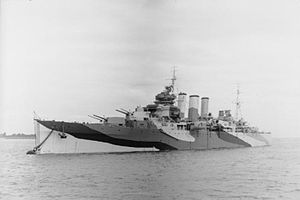HMAS Shropshire
 |
|
| History | |
|---|---|
|
|
|
| Name: | HMS Shropshire |
| Namesake: | Shropshire, England |
| Ordered: | 17 March 1926 |
| Builder: | William Beardmore and Company (Dalmuir, Scotland) |
| Laid down: | 24 February 1927 |
| Launched: | 5 July 1928 |
| Completed: | 12 September 1929 |
| Commissioned: | 24 September 1929 |
| Decommissioned: | 23 December 1942 |
| Identification: | Pennant number: 73, later 83, later 96 |
| Honours and awards: |
|
| Fate: | Transferred to RAN |
|
|
|
| Name: | HMAS Shropshire |
| Commissioned: | 20 April 1943 |
| Decommissioned: | 10 November 1949 |
| Motto: | "Floreat Ambo" |
| Honours and awards: |
|
| Fate: | Sold for scrapping, 16 July 1954 |
| General characteristics | |
| Class and type: | County-class heavy cruiser |
| Displacement: |
|
| Length: | 633 ft (193 m) |
| Beam: | 66 ft (20 m) |
| Draught: | 21 ft (6.4 m) |
| Propulsion: |
|
| Speed: | 32 knots (59 km/h; 37 mph) |
| Range: |
|
| Complement: | 690 (peace), 1,000 (war) |
| Armament: |
|
| Armour: | |
| Aircraft carried: | One aircraft, one catapult. Three planes used during service; Fairey III, Hawker Osprey, Supermarine Walrus |
HMS Shropshire was a Royal Navy (RN) heavy cruiser of the London sub-class of County-class cruisers. She is the only warship to have been named after Shropshire, England. Completed in 1929, Shropshire served with the RN until 1942, when she was transferred to the Royal Australian Navy (RAN) following the loss of sister ship HMAS Canberra. Commissioned as HMAS Shropshire, the ship remained in RAN service until 1949, and was sold for scrap in 1954.
Shropshire was one of four heavy cruisers built to the London design of the County-class cruisers. The cruiser had a displacement of 9,830 tons at standard load, was 632.75 feet (192.86 m) long overall, 595 feet (181 m) long between perpendiculars, and had a beam of 66 feet (20 m).
The propulsion system consisted of eight Yarrow-type boilers, which fed Parsons geared turbines. These generated 80,000 shaft horsepower, which was fed to the ship's four 11-foot (3.4 m) diameter propellers. The cruiser could reach speeds of up to 32.25 knots (59.73 km/h; 37.11 mph), with 12 knots (22 km/h; 14 mph) as the designated economical speed. At economical speed, she could travel 8,700 nautical miles (16,100 km; 10,000 mi).
The cruiser's initial armament consisted of eight BL 8 inch Mk VIII naval guns in four twin turrets, four single QF 4 inch Mk V naval guns and four single QF 2 pounder naval guns (or pom-poms) for anti-aircraft defence, four 3-pounder guns, and a number of smaller calibre guns for point defence. During the 1930s, two 0.5-inch machine guns were added to the point defence armament.
Shortly before transfer to the RAN in 1943, Shropshire underwent a refit. Although the main armament was unchanged, the 4-inch guns were upgraded to twin mountings, while the anti-aircraft armament was replaced with eighteen 20 mm Oerlikon guns (seven twin mountings and four single mountings) and two QF 2-pounder Mark VI eight-barrelled pom-poms. The 3-pounder guns were deleted, while two quadruple-tube launchers for 21-inch torpedoes and several depth charge chutes were installed. During the same refit, the cruiser ceased operating its seaplane, and the aircraft catapult was removed.
...
Wikipedia
